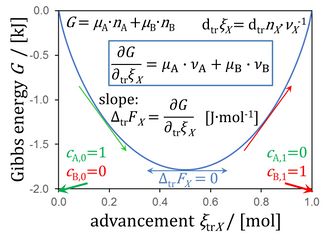Difference between revisions of "Gibbs energy"
From Bioblast
| Line 4: | Line 4: | ||
|info=<u>[[Energy]]</u> | |info=<u>[[Energy]]</u> | ||
}} | }} | ||
[[File:Gibbs energy advancement.png|right|330px|link=Gnaiger_2020_BEC_MitoPathways#Chapter_8._Protonmotive_pressure_and_respiratory_control |Gibbs energy and advancement|thumb|Figure 8.5. Gibbs energy as a function of advancement of transformation in a closed isothermal system at constant pressure ([[Gnaiger 2020 BEC MitoPathways]]).]] | [[File:Gibbs energy advancement.png|right|330px|link=Gnaiger_2020_BEC_MitoPathways#Chapter_8._Protonmotive_pressure_and_respiratory_control |Gibbs energy and advancement|thumb|Figure 8.5. Gibbs energy as a function of advancement of transformation in a closed isothermal system at constant pressure (modified from [[Gnaiger 2020 BEC MitoPathways]]).]] | ||
== Gibbs energy as a function of advancement == | == Gibbs energy as a function of advancement == | ||
Communicated by [[Gnaiger E]] 2022-10- | Communicated by [[Gnaiger E]] 2022-10-17 | ||
:::: In a transformation tr 0 = -1 A +1 B proceeding in a system with volume ''V'' at constant barometric pressure ''p'', the Gibbs energy of reactants A and B is | :::: In a transformation tr 0 = -1 A +1 B proceeding in a system with volume ''V'' at constant barometric pressure ''p'', the Gibbs energy of reactants A and B is | ||
Revision as of 11:37, 17 October 2022
Description
Gibbs energy G [J] is exergy which cannot be created internally (subscript i), but in contrast to internal-energy (diU/dt = 0) is not conserved but is dissipated (diG/dt < 0) in irreversible energy transformations. Exergy is available as work in reversible energy transformations, and can be partially conserved when the exergonic transformation is coupled to an endergonic transformation.
Abbreviation: G [J]
Reference: Energy

Figure 8.5. Gibbs energy as a function of advancement of transformation in a closed isothermal system at constant pressure (modified from Gnaiger 2020 BEC MitoPathways).
Gibbs energy as a function of advancement
Communicated by Gnaiger E 2022-10-17
- In a transformation tr 0 = -1 A +1 B proceeding in a system with volume V at constant barometric pressure p, the Gibbs energy of reactants A and B is
Eq. 1: G = µA·nA + µB·nB [J]
- A small change dG at constant chemical potentials µi is due to a small advancement of the transformation, in closed or open isothermal systems, exchanging heat in equilibrium with an external thermostat at constant temperature,
Eq. 2: dtrG = µA·dtrnA + µB·dtrnB [J]
- where the advancement dtrξi (i = A or B) is
Eq. 3: dtrξi = dtrnA·νA-1 = dtrnB·νB-1 [mol]
- The isomorphic force of transformation ΔtrFX is the derivative of exergy per advancement,
Eq. 4: ΔtrFX = ∂G/∂trξX [J·mol-1]
- Note that ∂G ≝ dtrG. Then inserting Eq. 2 and Eq. 3 into Eq. 4, the force of transformation is expressed as
Eq. 5: ΔtrFX = (µA·dtrnA + µB·dtrnB)/(dtrnB·νB-1) [J·mol-1]
- which can be rewritten as
Eq. 6: ΔtrFX = µA·dtrnA/(dtrnA·νA-1) + µB·dtrnB/(dtrnB·νB-1) [J·mol-1]
- This yields the force as the sum of stoichiometric potentials, summarized in Figure 8.5 (Chapter 8; Gnaiger 2020 BEC MitoPathways),
Eq. 7: ΔtrFX = µA·νA + µB·νB [J·mol-1]
- »Bioblast links: Energy and exergy - >>>>>>> - Click on [Expand] or [Collapse] - >>>>>>>
- Units
- Joule [J]; 1 J = 1 N·m = 1 V·C; 1 cal = 4.184 J
- Units
- Fundamental relationships
- » Energy
- » Exergy
- » Extensive quantity
- Fundamental relationships
- Contrast
- » Force
- » Pressure
- » Intensive quantity
- Contrast
- Forms of energy
- » Internal-energy dU
- » Enthalpy dH
- » Heat deQ
- » Bound energy dB
- Forms of energy
- Forms of exergy
- » Helmholtz energy dA
- » Gibbs energy dG
- » Work deW
- » Dissipated energy diD
- Forms of exergy
MitoPedia concepts:
Ergodynamics
